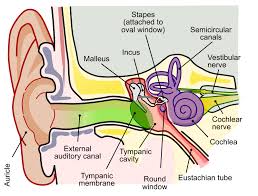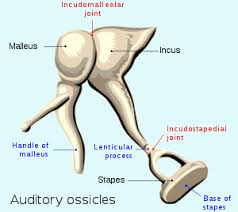

The ossicles, also called auditory ossicles, are three bones in either middle ear that are among the smallest bones in the human body.
Ossicles serve to transmit sounds from the air to the fluid-filled labyrinth, the cochlea.
The absence of the auditory ossicles would constitute a moderate-to-severe hearing loss.
Typically refers to the malleus, incus, and stapes (hammer, anvil, and stirrup) of the middle ear.
The ossicles are, in order from the eardrum to the inner ear, or from superficial to deep : the malleus, incus, and stapes.
The malleus articulates with the incus through the incudomalleolar joint and is attached to the tympanic membrane, from which vibrational sound pressure motion is passed.
The incus is connected to both the other bones.
The stapes articulates with the incus through the incudostapedial joint and is attached to the membrane of the fenestra ovalis, the elliptical or oval window or opening between the middle ear and the vestibule of the inner ear.
The stapes is the smallest bone in the body.
The middle ear, and is made up of the stapes, incus, malleus, and tympanic membrane.
Sound waves vibrate the tympanic membrane which, in turn, moves the nearest ossicle, the malleus, to which it is attached.
The malleus transmits the vibrations, via the incus, to the stapes, and so ultimately to the membrane of the fenestra ovalis the opening to the vestibule of the inner ear.
Sound that travels through the air is mostly reflected when it comes into contact with a liquid medium.
Approximately 1/30 of sound energy moving through the air would be transferred into the liquid, explaining the abrupt cessation of sound that occurs when the head is submerged underwater.
This is explained by the relative incompressibility of a liquid’s resistance to the force of the sound waves traveling through the air.
The ossicles provide the eardrum a mechanical advantage with lever action and a reduction in the area of force distribution.
This the results in vibrations that are stronger but don’t move as far,
allowing more efficient coupling than if the sound waves were transmitted directly from the outer ear to the oval window.
This reduction in the area of force application allows a large enough increase in pressure to transfer most of the sound energy into the liquid.
The increased pressure will compress the fluid found in the cochlea and transmit the stimulus.
The lever action of the ossicles changes the vibrations so as to improve the transfer and reception of sound, and is a form of impedance matching.
The extent of the movements of the ossicles is controlled/constricted and constricted by two muscles attached to them: the tensor tympani and the stapedius.
These muscles can contract to dampen the vibration of the ossicles to protect the inner ear from excessively loud noise and that they give better frequency resolution at higher frequencies by reducing the transmission of low frequencies.
Otosclerosis, results in the fusing of the stapes to the oval window, which reduces hearing and may be treated surgically using a passive middle ear implant.
